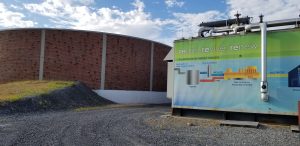Clean and Green: How Waste is Turned into Energy at Kline’s Island
February 27, 2019
Did you know that bacteria are hard at work producing between 35 and 50 percent of the electricity required to treat Allentown’s wastewater?
That’s because they’re helping create renewable energy used to fuel a biogas generator, which in turn supplies electricity and heat at LCA’s Kline’s Island Wastewater Treatment Plant.
Here’s how it works:
Biogas is produced when organic waste decomposes in the absence of oxygen. During the wastewater treatment process at Kline’s Island, solid waste goes into two “digesters” — tanks where bacteria break down the waste. The tanks are kept at a steady 99 degrees Fahrenheit for 20 days to provide the bacteria with optimal working conditions.
As the waste decomposes, it produces methane gas and carbon dioxide. The gas is captured and piped to a generator, where it’s burned as fuel. The byproduct of that process is electricity (which is sold back to LCA to run the plant) and heat (used to keep the digesters warm). In 2018, the digesters produced about 290 to 350 thousand cubic feet of biogas per day.
The Combined Heat and Power (CH&P) project actually got its start almost 20 years ago, when PPL installed 12 microturbines — small generators powered by methane-fueled jet engines — to produce electricity.
In 2012, PPL decided to upgrade the project, and in 2014 a single, new generator began operating. It’s powered by a massive Caterpillar diesel engine that’s been converted to also run on methane.
It’s a fantastic way to reduce costs and lessen the environmental footprint of the wastewater treatment process. Biogas generators can be used almost anywhere there’s a supply of organic material, including food waste, plant matter and livestock manure. You can even build your own to use at home — check out this article from Mother Earth News.
For the rest in our Behind the Scenes series, please see:
Wastewater Treatment Starts with Screening Out Items That Don’t Belong
Why Does Wastewater Need to be Treated?
Pump it Up: The Role of LCA’s Giant Wastewater Movers
Sludge 101: How Solids Are Removed From Wastewater
The Sludge Report: What Happens After Treatment?
How Is Liquid Waste Treated? It’s All About Biology
Tertiary Nitrification: How Ammonia Is Removed From Wastewater
Disinfection and Testing — the Final Steps in Wastewater Treatment